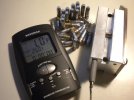...We might be setting the measurement bar a bit too precise only because WE CAN, not because we need to.
Honestly, I see it much like bottom-pour v. ladle or PC v. traditional lube. I don't see either option in any of the three examples as being objectively better overall as much as suiting the user.
Either way works and most of us can manage either way - it's more a matter of what little details each of us chooses to favor. I personally do not employ a lot of "technology" at home, especially doing what I do for enjoyment. Technology is what I do for a living and I leave as much of that AT work as I can.
This is not to dismiss the important details of BP/ladle or PC/traditional. There are definitely advantages to either option in all three cases. What's "better" is is specific to a user.
There's a lot I like about PC, but I can't say it's better. I use both and lean more heavily to tumble-lube.
I ladled for many years and struggled with bottom-pour for a while, but now prefer it ALMOST across the board.
I CAN cast the old way, but a PID controller (in my world) is sort of the down and dirty way to control process heating and it's easy enough to implement.
NOW, if you want to be able to do a ramp-soak, like for PC'ing, and store "recipes" for various operations, the little controllers can do that for you, while you finish sweeping the garage, empty the tumbler, run to the can, etc. Those cost a few buck more, but there is still potential to exploit.
I actually make all my students design and build control systems using old-fashioned, hard-wired electro-mechanical devices (including antique pneumatic timers) before they go to the next class and emulate the same using a computer - a PLC. Makes a huge difference in their ability to master the technology when they've mastered the more manual aspects of it. So again - I use both.


